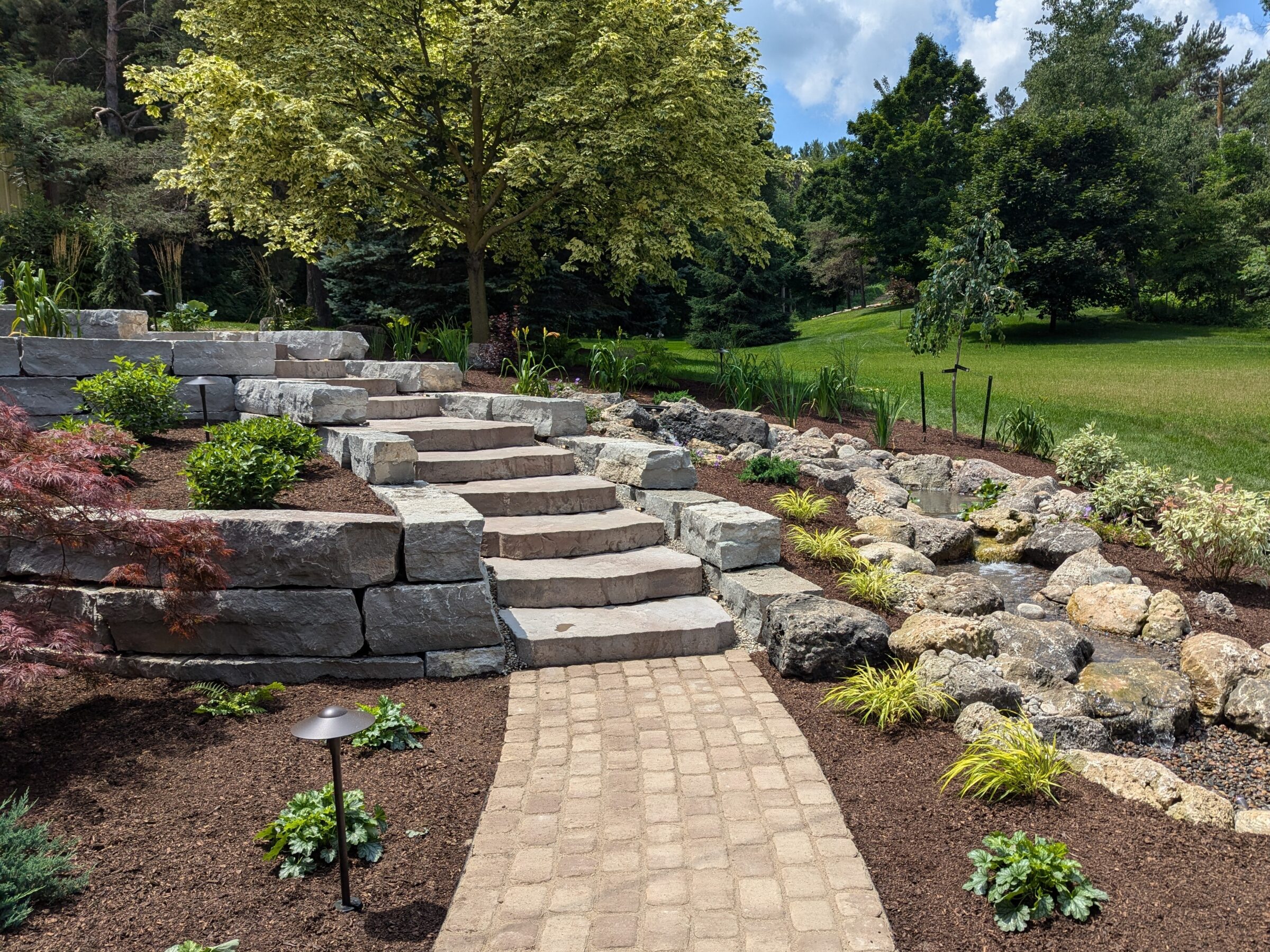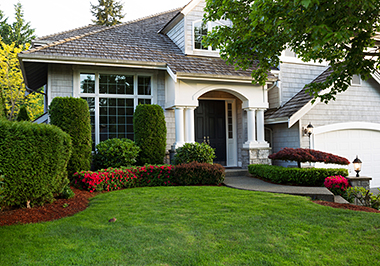Recognizing the Comprehensive Scope of Functions in Professional Landscape Design Services
The considerable range of professional landscaping services includes a range of fundamental components - landscaping services. It consists of landscape layout principles, plant option, and hardscaping attributes. Furthermore, it attends to irrigation systems and upkeep techniques. Each element plays a vital role in producing practical and aesthetically pleasing outdoor rooms. Recognizing just how these elements interact can reveal much concerning the art and scientific research of landscaping. However, the journey into this intricate field is simply beginning
Landscape Design Principles
Reliable landscape design concepts are vital for developing harmonious exterior areas that boost both aesthetic allure and performance (Learn More). These principles lead the arrangement of elements within the landscape, making sure a natural visual experience. Secret parts include balance, which disperses aesthetic weight evenly; proportion, which associates the dimension of various components to every various other and the area; and unity, which develops a sense of wholeness with consistent motifs and products

Plant Selection and Installation
In the domain name of expert landscaping, plant option and installation play an essential role in attaining a prospering garden. Emphasizing indigenous plant advantages, seasonal considerations, and the specific soil and sunshine demands of each varieties ensures a sustainable and visually pleasing landscape. Careful planning in these areas not just enhances biodiversity however likewise promotes long-term environmental health.
Native Plant Advantages
Why should homeowners consider native plants for their landscaping jobs? Native plants use countless benefits that enhance both appearances and ecological sustainability. They are well-adapted to local climates, requiring less water and maintenance compared to non-native species. This strength lowers the demand for chemical plant foods and chemicals, promoting a much healthier ecosystem. Additionally, indigenous plants give environment and food for regional wild animals, including pollinators, which can boost biodiversity in suburbs. Their familiarity with neighborhood dirt and climate problems likewise causes better development rates and longevity. By choosing native plants, property owners not only produce visually attractive landscapes yet likewise contribute to eco-friendly conservation, making a favorable impact on their local atmosphere. Subsequently, native plants represent a wise option for landscape design jobs.
Seasonal Plant Considerations
Homeowners that have actually embraced native plants in their landscaping can further boost their outdoor areas by considering seasonal plant selections. By incorporating plants that grow in certain periods, they can produce vibrant and aesthetically enticing landscapes throughout the year. Springtime might introduce vivid blossoms like tulips and daffodils, while summer season can showcase lavish vegetation and colorful perennials. Fall presents a scheme of warm tones with goldenrods and asters, while winter months can be highlighted with evergreens and decorative yards for texture. Professional landscapers frequently suggest selecting plants that not only enhance existing native varieties but likewise offer year-round interest and support local wild animals. This thoughtful method to seasonal plant choice assures a continuously developing and lasting garden environment.
Dirt and Sunshine Requirements
Successful landscape design rests on comprehending the certain dirt and sunlight requirements of plants. Different species flourish under varying problems, calling for a mindful evaluation of both factors throughout the selection procedure. Dirt kinds, such as sandy, clay, or fertile, impact drain, vitamins and mineral schedule, and origin advancement. Additionally, pH levels can affect plant health, necessitating soil screening to determine suitability. Sunlight demands vary substantially; some plants prosper completely sun, while others favor partial or full color. An expert landscaper considers these aspects to guarantee peak growth and aesthetic charm. By lining up plant choices with the setting's specific qualities, landscapes can attain sustainability, resilience, and aesthetic consistency, eventually causing successful plant facility and long-lasting upkeep.
Hardscaping Features and Construction

While landscaping often stimulates pictures of lush greenery and lively blossoms, hardscaping functions play a crucial function in defining outside spaces. These components, which consist of patio areas, walkways, keeping wall surfaces, and attractive stonework, supply framework and capability to gardens and lawns. Hardscaping makes use of materials such as concrete, block, stone, and wood, permitting varied layouts that complement the natural landscape.
The building of hardscaping features calls for cautious preparation and execution to assure sturdiness and aesthetic charm. Experts analyze website problems, drainage, and spatial relationships to develop cohesive exterior atmospheres. Correct setup methods are vital, as they prevent issues like disintegration and moving in time.
Including hardscaping not just enhances the aesthetic interest of a residential property however additionally helps with outside activities, making it a basic element of detailed landscaping services. Inevitably, thoughtful hardscaping adds to both the capability and charm of outdoor areas.
Irrigation Systems and Water Administration
Reliable irrigation systems and water monitoring are important elements of expert landscape design, as they guarantee that plants receive the necessary hydration for excellent growth. These systems can differ from straightforward drip watering setups to innovative automatic sprinkler systems, made to meet the specific demands of varied landscapes. Appropriate water management not only optimizes water usage, reducing waste, however additionally enhances plant health and reduces disease threats.
Landscaping specialists analyze numerous aspects, including soil type, plant varieties, and neighborhood environment, to create customized watering options. Additionally, incorporating rain harvesting strategies can further improve sustainability and performance. Regular maintenance of irrigation systems is important to keep capability and prevent leakages, which can bring about water loss and raised expenses (Learn More). Eventually, a well-designed watering system plays a pivotal duty in preserving the aesthetic charm of exterior areas while advertising environmental stewardship within professional landscaping techniques
Grass Treatment and Upkeep Methods
Yard care and maintenance methods are essential for achieving a lush, healthy lawn that improves the general landscape. These strategies incorporate various methods aimed at promoting suitable growth and aesthetic charm. Normal mowing is important, as it motivates thick, even development while avoiding weeds from establishing. Furthermore, proper fertilization provides required nutrients, with applications tailored to the certain turf type and dirt conditions.
Watering techniques should concentrate on deep, infrequent watering to encourage root development, while aeration improves soil framework and promotes nutrient absorption. Parasite and condition management is also vital; identifying concerns early permits effective treatments that minimize damage.
Overseeding can rejuvenate damaged or thin yards, boosting thickness and shade (landscaping). By applying these targeted grass treatment approaches, landscape design professionals can guarantee that yards remain healthy and vibrant throughout the periods, substantially adding to the overall charm of the building
Seasonal Landscape Treatment and Maintenance
As the seasons change, appropriate landscape treatment comes to be vital for maintaining the health and appeal of outdoor spaces. Each season offers one-of-a-kind challenges and needs. In spring, landscape specialists concentrate on pruning, growing, and feeding to urge development. Summer demands normal watering, weed control, and parasite management to safeguard freshly developed plants.

Throughout the year, seasonal landscape maintenance guarantees that exterior locations remain visually enticing and healthy and balanced. Specialist services can offer tailored upkeep strategies that adjust to the certain requirements of each period, enabling home owners to appreciate dynamic landscapes year-round. In general, seasonal treatment is a crucial facet of expert landscaping that advertises long life and visual worth.

Lasting Landscape Design Practices
An expanding variety of homeowner are accepting sustainable landscaping methods to create eco-friendly outdoor areas. These techniques concentrate on conserving sources, boosting biodiversity, and reducing ecological impact. Native plants are frequently selected for their low water demands and compatibility with regional communities, lowering the requirement for chemical fertilizers and pesticides. Rain yards and permeable paving are used to manage stormwater drainage, advertising groundwater recharge and reducing erosion.
In addition, sustainable landscaping includes organic horticulture techniques that prioritize soil health and wellness and advertise natural pest control. Effective irrigation systems, such as drip watering and rainwater harvesting, aid optimize water usage. Furthermore, landscape designers significantly advocate for the use of recycled products, such as redeemed wood and rocks, to lessen waste. By taking on these lasting practices, homeowner not only add to eco-friendly preservation yet also create cosmetically pleasing environments that can love marginal upkeep.
Often Asked Concerns
For how long Does a Landscape Design Project Typically Require To Full?
Generally, a landscape design task can take anywhere from a few days to a number of weeks to complete, depending upon the job's layout, complexity, and dimension needs. Variables such as climate and resource availability also influence timelines.
What Elements Influence the Price of Landscape Design Services?
Numerous elements influence landscaping service expenses, consisting of task size, layout complexity, material high quality, labor expenditures, geographical location, and seasonal need. Each aspect contributes uniquely to the general economic requirements of a landscaping job.
Are Landscaping Services Available Year-Round?
Landscaping services are generally offered year-round, although schedule may differ based on area, seasonal climate problems, and details service offerings. Some services may be restricted throughout extreme weather condition or off-peak periods.
Do Landscape Design Companies Deal Warranties on Their Work?
Several landscape design companies do offer service warranties on their work, which can differ in size and insurance coverage. Customers are urged to inquire concerning certain terms, guaranteeing they recognize what is guaranteed and any conditions that use.
Can I Style My Landscape Without Professional Aid?
Yes, individuals can make their landscapes without specialist help. Nonetheless, they may do not have experience in plant option, format, and environmental factors to consider, potentially causing less efficient layouts that might require pricey changes later.
In the domain of specialist landscaping, plant choice and installment play an essential function in achieving a growing garden. Homeowners that have actually more info accepted native plants in their landscaping can even more boost their outdoor spaces by taking into consideration seasonal plant selections. Successful landscaping hinges on recognizing the particular soil and sunlight requirements of plants. Effective watering systems and water monitoring are important components of expert landscaping, as they assure that plants obtain the necessary hydration for perfect growth. Landscape design specialists analyze different variables, consisting of dirt kind, plant species, and neighborhood environment, to create tailored irrigation remedies.